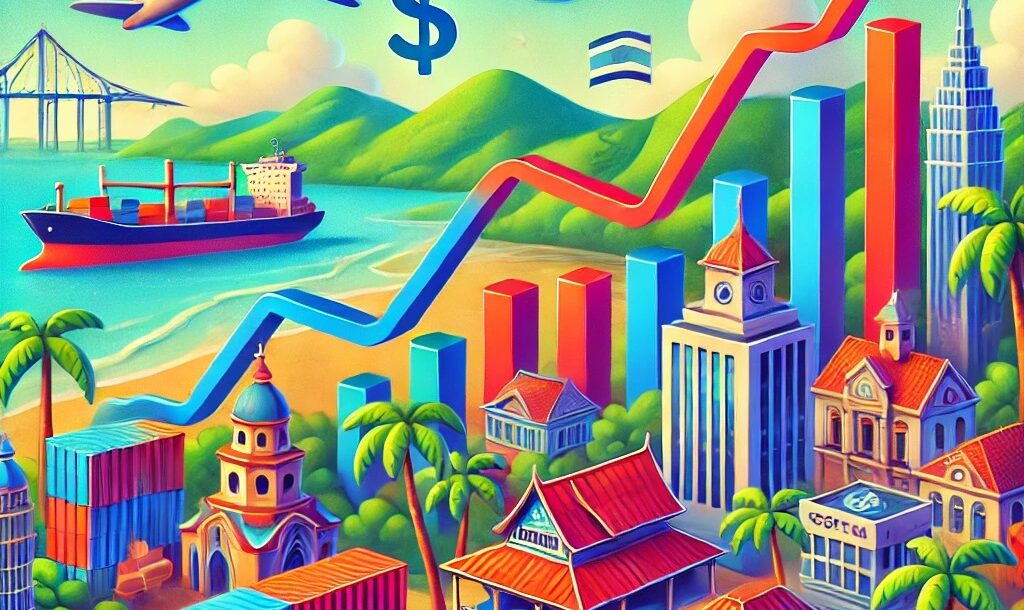Why is the Exchange Rate Falling in Costa Rica, and How Long Could This Trend Last?
The exchange rate in Costa Rica has been declining over recent years. Although some factors that explained this trend in 2022 and 2023 have lost momentum, the colón continues to appreciate. To understand this, let’s break down the main causes and what could happen in the future.
1. How is the exchange rate determined?
The price of the dollar in Costa Rica, as in any market, depends on supply and demand:
- If there is an excess of dollars available (high supply) compared to what people and businesses need (low demand), the price of the dollar decreases.
- If fewer dollars are available and demand is high, the price of the dollar increases.
Currently, there is an excess supply of dollars (surplus) in the market, keeping its price low.
2. Why was there such a large dollar surplus between 2022 and 2023?
a. Economic recovery and international trade:
- Service exports: Costa Rica exports more services (such as software and back-office solutions) than it imports in goods, generating a positive net dollar flow.
- Tourism: Post-pandemic tourist arrivals surpassed pre-COVID levels, injecting foreign currency into the economy.
- Free trade zones and foreign direct investment (FDI): Multinational companies regularly bring in dollars to cover operations (salaries, utilities, rentals), creating a steady flow of dollars.
b. High interest rates in colones:
- During 2022 and 2023, the Central Bank increased the Monetary Policy Rate (MPR) to 9%. This made investing in colones more attractive, prompting many to convert dollars into colones, further boosting dollar supply.
c. External financing:
- The government issued eurobonds in 2023 and received international loans. While these dollars don’t directly enter the foreign exchange market, they reduce the need to purchase dollars for debt payments, lowering demand.
3. What’s happening in 2024?
Many temporary factors (cyclical) have weakened:
- Interest rates in colones have decreased (MPR at 4%), reducing their appeal.
- No new eurobond issues have occurred this year.
- Growth in exports and foreign investment has slowed.
Yet, the exchange rate continues to decline due to structural changes in Costa Rica’s economy that create a consistent supply of dollars:
- Free trade zones and foreign investment continue to operate strongly, generating monthly inflows of dollars.
- Tourists keep arriving in large numbers, maintaining Costa Rica’s appeal as a destination.
- While the dollar surplus is smaller than in 2023, it remains high compared to previous years.
Additionally, dollar demand has not increased significantly:
- Despite lower interest rates, there hasn’t been a massive increase in dollar-denominated savings.
- The government still holds reserves from the 2023 eurobond issues, reducing its need to purchase dollars.
4. How long could this trend last?
Predicting exact movements in the exchange rate is challenging, but signs suggest that the abundance of dollars could persist in the medium term:
- Free trade zones and foreign investment provide a steady inflow of dollars.
- Tourism and exports are likely to continue contributing to dollar supply.
- The current dollar surplus remains significant, even if smaller than in 2023.
However, there are factors that could reverse this trend:
- Weakening of exporters outside free trade zones:
- Agricultural and tourism exporters could struggle if the colón appreciates too much, making their products less competitive internationally.
- Government reserves depletion:
- When the Ministry of Finance depletes its dollar reserves from previous eurobond issues, it may need to purchase more dollars in the market, increasing demand.
- Global crises:
- Geopolitical conflicts (e.g., in Ukraine or the Middle East) could disrupt trade flows and affect dollar availability.
Conclusion: What to expect from the exchange rate?
Long-term trend:
- If Costa Rica continues to attract foreign investment and maintain competitiveness in service exports, the dollar supply is likely to remain high, keeping the exchange rate low.
Reversal risks:
- Factors like weakening agricultural exports or fiscal challenges could alter this dynamic, potentially increasing the exchange rate.
In summary, while structural changes remain in play, the colón is likely to stay strong. However, cyclical factors such as new eurobond issues or rate adjustments will determine whether this trend is sustainable in the coming years.
- #CostaRicaEconomy, #ExchangeRateTrends, #DollarVsColon, #ForeignInvestment, #FinancialInsights
Source: El Financiero




